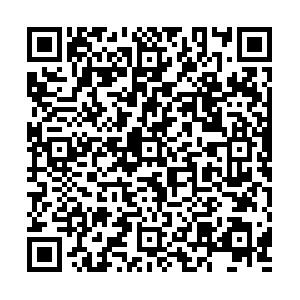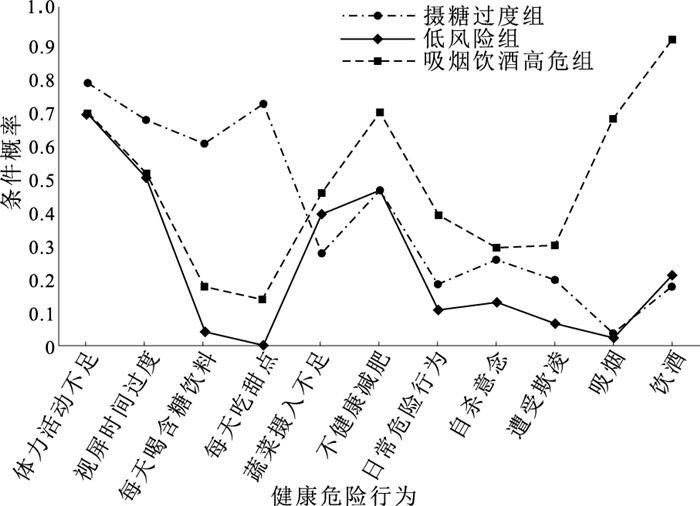Association of adverse childhood experiences with cumulative health risk behaviors among college students
-
摘要:
目的 了解大学生健康危险行为的聚集模式,探索童年不良经历与聚集性健康危险行为的关联,为大学生健康危险行为防控提供理论依据。 方法 2022年11—12月,采用方便抽样方法抽取上海市4所大学,再运用整群随机抽样方法选取3 039名学生开展问卷调查,调查内容包括一般基本信息、童年不良经历和健康危险行为。通过潜在类别分析探索大学生健康危险行为的潜在分类,并运用多元Logistic回归分析童年不良经历与聚集性健康危险行为的关联。 结果 大学生健康危险行为可分为低风险组、吸烟饮酒高危组和摄糖过度组3个类别,占比分别为84.60%,10.37%和5.03%。童年时期有无虐待忽视、家庭功能不良及其他逆境的大学生在健康危险行为3个潜在类别组的分布差异均有统计学意义(χ2值分别为210.67,106.55,104.41,P值均<0.01)。多元Logistic回归分析结果显示,童年期虐待忽视、家庭功能不良、其他逆境均增加大学生吸烟饮酒高危组的发生风险(OR值分别为6.24,3.80,3.68),童年期虐待忽视增加大学生摄糖过度组的发生风险(OR=2.18)(P值均<0.01)。 结论 大学生童年不良经历与聚集性健康危险行为之间存在关联。采取积极措施预防童年不良经历的发生,有助于减少大学生健康危险行为的发生。 Abstract:Objective To understand cumulative health risk behaviors among college students and the association with adverse childhood experiences, so as to provide a theoretical basis for the prevention and control of health risk behaviors in this population. Methods From November to December 2022, four universities in Shanghai were selected using convenience sampling, and 3 039 students were selected for a questionnaire survey using random cluster sampling. The questionnaire covered general basic information, adverse childhood experiences and health risk behaviors. A latent class analysis was carried out to explore the latent classes of health risk behaviors among the college students and multivariate Logistic regression was performed to analyze the association between adverse childhood experiences and cumulative health risk behaviors. Results The health risk behaviors of college students were classified into three latent classes: a low-risk group (84.60%), a high-risk group for smoking and alcohol consumption (10.37%), and an excessive sugar intake group (5.03%). The proportion of three latent classes of health risk behaviors varied significantly by childhood neglect and abuse, family functioning and other adverse childhood experiences (χ2=210.67, 106.55, 104.41, P < 0.01). The results of the multiple Logistic regression analysis revealed that childhood neglect and abuse, poor family functioning, and other adversities increased the risk in the high-risk group for smoking and alcohol consumption among college students (OR=6.24, 3.80, 3.68), as well as an childhood neglect and abuse increased the risk of the excessive sugar intake group among college students (OR=2.18) (P < 0.01). Conclusions Adverse childhood experiences are associated with clustered health risk behaviors. Proactive measures should be taken to prevent the transmission of negative childhood experiences, which would contribute to reduce the occurrence of health risk behaviors among college students. -
Key words:
- Child abuse /
- Dangerous behavior /
- Regression analysis /
- Students
1) 利益冲突声明 所有作者声明无利益冲突。 -
表 1 不同性别大学生健康危险行为报告率比较
Table 1. Comparison of reported rates of health risk behaviors among college students of different genders
性别 人数 体力活动不足 过度使用视屏电子产品 每天喝含糖饮料 每天吃甜点 蔬菜摄入不足 不健康减肥 日常危险行为 自杀意念 遭受欺凌 吸烟 饮酒 男 1 217 711(58.42) 547(44.95) 133(10.93) 65(5.34) 464(38.13) 502(41.25) 190(15.61) 172(14.13) 129(10.60) 205(16.84) 411(33.77) 女 1 822 1 402(76.95) 998(54.77) 150(8.24) 129(7.08) 715(39.24) 970(53.24) 247(13.56) 344(18.88) 180(9.88) 105(5.76) 469(25.74) 合计 3 039 2 113(69.53) 1 545(50.84) 283(9.31) 194(6.38) 1 179(38.80) 1 472(48.44) 437(14.38) 516(16.98) 309(10.17) 310(10.20) 880(28.96) χ2值 118.20 28.20 6.28 3.69 0.38 41.99 2.50 11.67 0.42 97.82 22.87 P值 <0.01 <0.01 0.01 0.06 0.54 <0.01 0.11 <0.01 0.52 <0.01 <0.01 注:()内数字为报告率/%。 表 2 大学生健康危险行为潜在类别模型拟合指数(n=3 039)
Table 2. Latent class model fit index of health risk behaviors among college students(n=3 039)
类别 AIC值 BIC值 aBIC值 Entropy值 PLMR值 PBLRT值 条件概率 1 32 783.46 32 855.69 32 817.57 — — — — 2 32 029.40 32 179.88 32 100.45 0.69 <0.01 <0.01 0.15/0.85 3 31 774.48 32 003.22 31 882.48 0.83 <0.01 <0.01 0.05/0.85/0.10 4 31 635.91 31 942.89 31 780.84 0.74 <0.01 <0.01 0.08/0.74/0.15/0.03 5 31 529.47 31 914.70 31 711.35 0.64 <0.01 <0.01 0.08/0.03/0.14/0.30/0.45 表 3 不同组别大学生健康危险行为潜在类别分布比较
Table 3. Comparison of latentclasses distribution of health risk behaviors among college students with different groups
组别 选项 人数 低风险组 吸烟饮酒高危组 摄糖过度组 χ2值 P值 性别 男 1 217 985(80.94) 185(15.20) 47(3.86) 54.57 <0.01 女 1 822 1 586(87.05) 130(7.13) 106(5.82) 年级 大一 942 827(87.79) 72(7.64) 43(4.56) 28.14 <0.01 大二 862 735(85.27) 75(8.70) 52(6.03) 大三 778 643(82.65) 99(12.72) 36(4.63) 大四 457 366(80.09) 69(15.10) 22(4.81) BMI/(kg·m-2) <18.5 607 528(86.99) 39(6.42) 40(6.59) 20.11 <0.01 18.5~23.9 1 772 1 493(84.26) 198(11.17) 81(4.57) 24.0~27.9 449 382(85.08) 50(11.14) 17(3.79) ≥28.0 211 168(79.62) 28(13.27) 15(7.11) 父亲文化程度 小学及以下 358 295(82.40) 55(15.36) 8(2.23) 23.75 <0.01 初中 637 547(85.87) 66(10.36) 24(3.77) 高中 815 680(83.44) 88(10.80) 47(5.77) 大专及以上 1 229 1 049(85.35) 106(8.62) 74(6.02) 母亲文化程度 小学及以下 512 406(79.30) 86(16.80) 20(3.91) 36.74 <0.01 初中 640 563(87.97) 52(8.13) 25(3.91) 高中 756 653(86.38) 69(9.13) 34(4.50) 大专及以上 1 131 949(83.91) 108(9.55) 74(6.54) 月生活费/元 <1 000 249 222(89.16) 19(7.63) 8(3.21) 82.84 <0.01 1 000~<2 000 1 262 1 121(88.83) 84(5.66) 57(4.52) 2 000~<3 000 1 059 889(83.95) 117(11.05) 53(5.00) ≥3 000 469 339(72.28) 95(20.26) 35(7.46) 至少存在一种童年不良经历 是 867 648(74.74) 176(20.30) 43(4.96) 129.46 <0.01 否 2 172 1 923(88.54) 139(6.40) 110(5.06) 童年期虐待忽视 有 450 287(63.78) 131(29.11) 32(7.11) 210.67 <0.01 无 2 589 2 284(88.22) 184(7.11) 21(1.21) 童年家庭功能不良 有 383 266(69.45) 97(25.33) 20(5.22) 106.55 <0.01 无 2 656 2 305(86.78) 218(8.21) 133(5.01) 童年其他逆境 有 558 405(72.58) 124(22.22) 29(5.20) 104.41 <0.01 无 2 481 2 166(87.30) 191(7.70) 124(5.00) 注:()内数字为构成比/%。 表 4 童年不良经历与大学生聚集性健康危险行为的Logistic回归分析[OR值(95%CI),n=3 039]
Table 4. Logistic regression analysis of adverse childhood experiences and aggregated health risk behaviors among college students [OR(95%CI), n=3 039]
自变量 吸烟饮酒高危健康危险行为 摄糖过度健康危险行为 模型1 模型2 模型1 模型2 至少存在一种童年不良经历 3.76(2.96~4.78)** 4.00(3.11~5.17)** 1.16(0.81~1.67) 1.25(0.87~1.80) 童年期虐待忽视 5.66(4.39~7.32)** 6.24(4.73~8.24)** 2.11(1.40~3.17)** 2.18(1.44~3.30)** 童年家庭功能不良 3.86(2.94~5.06)** 3.80(2.84~5.08)** 1.30(0.80~2.12) 1.31(0.80~2.14) 童年其他逆境 3.47(2.71~4.46)** 3.68(2.81~4.82)** 1.25(0.82~1.90) 1.42(0.93~2.17) 注:自变量分别以无童年不良经历、无童年期虐待忽视、无童年家庭功能不良和无童年其他逆境为参照组;模型1未调整变量,模型2调整性别、年级、BMI、父亲文化程度、母亲文化程度、月生活费;**P<0.01。 -
[1] GODDARD A. Adverse childhood experiences and trauma-informed ca re[J]. J Pediatr Health Care, 2021, 35(2): 145-155. doi: 10.1016/j.pedhc.2020.09.001 [2] BELLIS M A, HUGHES K, FORD K, et al. Life course health consequences and associated annual costs of adverse childhood experiences across Europe and North America: a systematic review and Meta-analysis[J]. Lancet Public Health, 2019, 4(10): e517-e528. doi: 10.1016/S2468-2667(19)30145-8 [3] ZHANG J, TANG B W, LIU M W, et al. Association of adverse childhood experiences with health risk behaviors among college students in Zambia[J]. Int J Behav Med, 2020, 27(4): 400-405. doi: 10.1007/s12529-020-09863-y [4] WIEHN J, HORNBERG C, FISCHER F. How adverse childhood experiences relate to single and multiple health risk behaviours in German public university students: a cross-sectional analysis[J]. BMC Public Health, 2018, 18(1): 1005. doi: 10.1186/s12889-018-5926-3 [5] PALMER T M, LAWLOR D A, HARBORD R M, et al. Using multiple genetic variants as instrumental variables for modifiable risk factors[J]. Stat Methods Med Res, 2012, 21(3): 223-242. doi: 10.1177/0962280210394459 [6] 王澳伦, 张天成, 徐涛, 等. 武陵山区大学生危害健康行为潜在类别及其与校园欺凌的关联[J]. 中国学校卫生, 2023, 44(5): 751-755. doi: 10.16835/j.cnki.1000-9817.2023.05.025 WANG A L, ZHANG T C, XU T, et al. Potential categories of health risk behaviors of college students in Wuling Mountain Area and its association with campus bullying[J]. Chin J Sch Health, 2023, 44(5): 751-755. (in Chinese) doi: 10.16835/j.cnki.1000-9817.2023.05.025 [7] WHATNALL M C, PATTERSON A J, BROOKMAN S, et al. Lifestyle behaviors and related health risk factors in a sample of Australian university students[J]. J Am Coll Health, 2020, 68(7): 734-741. doi: 10.1080/07448481.2019.1611580 [8] 苗春霞, 周崔红, 黄畅, 等. 不同性别大学生健康危险行为现状及影响因素研究[J]. 现代预防医学, 2021, 48(3): 491-495.MIAO C X, ZHOU C H, HUANG C, et al. Study on the status quo and influencing factors of health risk behaviors among college students of different genders[J]. Mod Prev Med, 2021, 48(3): 491-495. (in Chinese) [9] LI X, DESSIE Y, MWANYIKA-SANDO M, et al. Co-occurrence of and factors associated with health risk behaviors among adolescents: a multi-center study in sub-Saharan Africa, China, and India[J]. eClinicalMedicine, 2024, 70: 102525. doi: 10.1016/j.eclinm.2024.102525 [10] FINKELHOR D, SHATTUCK A, TURNER H, et al. A revised inventory of adverse childhood experiences[J]. Child Abuse Negl, 2015, 48: 13-21. doi: 10.1016/j.chiabu.2015.07.011 [11] 王艳荣, 林萍珍, 曹枫林. 中文儿童期不良经历问卷修订版的效度与信度[J]. 中国心理卫生杂志, 2018, 32(9): 760-764.WANG Y R, LIN P Z, CAO F L. Validity and reliability of the Chinese version of the Revised Adverse Childhood Experience Questionnaire[J]. Chin Ment Health J, 2018, 32(9): 760-764. (in Chinese) [12] 邓宇, 侯皓, 严娜, 等. 大学生童年期积极及不良经历与不确定心理压力的关联[J]. 中国学校卫生, 2022, 43(9): 1355-1358.DENG Y, HOU H, YAN N, et al. Associations between positive and negative childhood experiences and uncertainty stress in college students[J]. Chin J Sch Health, 2022, 43(9): 1355-1358. (in Chinese) [13] 季成叶. 青少年健康危险行为[J]. 中国学校卫生, 2007, 28(4): 289-291. doi: 10.3969/j.issn.1000-9817.2007.04.001JI C Y. Adolescent health risk behavior[J]. Chin J Sch Health, 2007, 28(4): 289-291. (in Chinese) doi: 10.3969/j.issn.1000-9817.2007.04.001 [14] 季成叶. 中国青少年健康相关/危险行为调查综合报告2005[M]. 北京: 北京大学医学出版社, 2007: 38-327.JI C Y. Investigation report on health risk behaviors of urban adoles-eents in China in 2005[M]. Beijing: Peking Universily Press, 2007: 38-327. (in Chinese) [15] 冯新熠, 闫旭, 董耀武. 天津某高校大学生视屏时间体力活动与颈肩痛的相关性[J]. 中国学校卫生, 2022, 43(9): 1412-1415, 1419. doi: 10.16835/j.cnki.1000-9817.2022.09.032 FENG X Y, YAN X, DONG Y W. Correlation between screen time, physicial activity as well as neck and shoulder pain among university students in Tianjin[J]. Chin J Sch Health, 2022, 43(9): 1412-1415, 1419. (in Chinese) doi: 10.16835/j.cnki.1000-9817.2022.09.032 [16] ZHOU B F, Cooperative Meta-analysis Group of the working group on obesity in China. Predictive values of body mass index and waist circumference for risk factors of certain related diseases in Chinese adults: study on optimal cut-off points of body mass index and waist circumference in Chinese adults[J]. Biomed Environ Sci, 2002, 15(1): 83-96. [17] GODOY L C, FRANKFURTER C, COOPER M, et al. Association of adverse childhood experiences with cardiovascular disease later in life: a review[J]. JAMA Cardiol, 2021, 6(2): 228-235. doi: 10.1001/jamacardio.2020.6050 [18] 王一诺, 刘洋, 庄绪秀, 等. 童年期不良经历对个体健康影响的研究进展[J]. 中国儿童保健杂志, 2022, 30(6): 632-636.WANG Y N, LIU Y, ZHUANG X X, et al. Research progress in health outcomes of adverse childhood experience[J]. Chin J Child Health Care, 2022, 30(6): 632-636. (in Chinese) [19] HOU H, ZHANG C, TANG J, et al. Childhood experiences and psychological distress: can benevolent childhood experiences counteract the negative effects of adverse childhood experiences?[J]. Front Psychol, 2022, 13: 800871. doi: 10.3389/fpsyg.2022.800871 [20] 王陈芳, 谢阳, 李婷婷, 等. 大学生睡眠时型与聚集性健康危险行为的关联[J]. 现代预防医学, 2021, 48(24): 4482-4486.WANG C F, XIE Y, LI T T, et al. Relationship between sleep chronotypes and aggregated health-risk behaviors of college students[J]. Mod Prev Med, 2021, 48(24): 4482-4486. (in Chinese) [21] LIU Y, ZHANG E, LI H, et al. Physical activity, recreational screen time, and depressive symptoms among Chinese children and adolescents: a three-wave cross-lagged study during the COVID-19 pandemic[J]. Child Adolesc Psychiatry Ment Health, 2024, 18(1): 11. doi: 10.1186/s13034-024-00705-3 [22] GBD 2021 Risk Factors Collaborators. Global burden and strength of evidence for 88 risk factors in 204 countries and 811 subnational locations, 1990-2021: a systematic analysis for the Global Burden of Disease Study 2021[J]. Lancet, 2024, 403(10440): 2162-2203. [23] YUSUF S, JOSEPH P, RANGARAJAN S, et al. Modifiable risk factors, cardiovascular disease, and mortality in 155 722 individuals from 21 high-income, middle-income, and low-income countries (PURE): a prospective cohort study[J]. Lancet, 2020, 395(10226): 795-808. doi: 10.1016/S0140-6736(19)32008-2 [24] MARTINASEK M P, WHELDON C W, PARSONS C A, et al. Understanding adverse childhood experiences as predictors of cigarette and e-cigarette use[J]. Am J Prev Med, 2021, 60(6): 737-746. doi: 10.1016/j.amepre.2021.01.004 [25] FORSTER M, ROGERS C J, TINOCO S, et al. Adverse childhood experiences and alcohol related negative consequence among college student drinkers[J]. Addict Behav, 2023, 136: 107484. [26] SCHULER B R, VAZQUEZ C, KOBULSKY J M, et al. The early effects of cumulative and individual adverse childhood experiences on child diet: examining the role of socioeconomic status[J]. Prev Med, 2021, 145: 106447. -







 下载:
下载:

